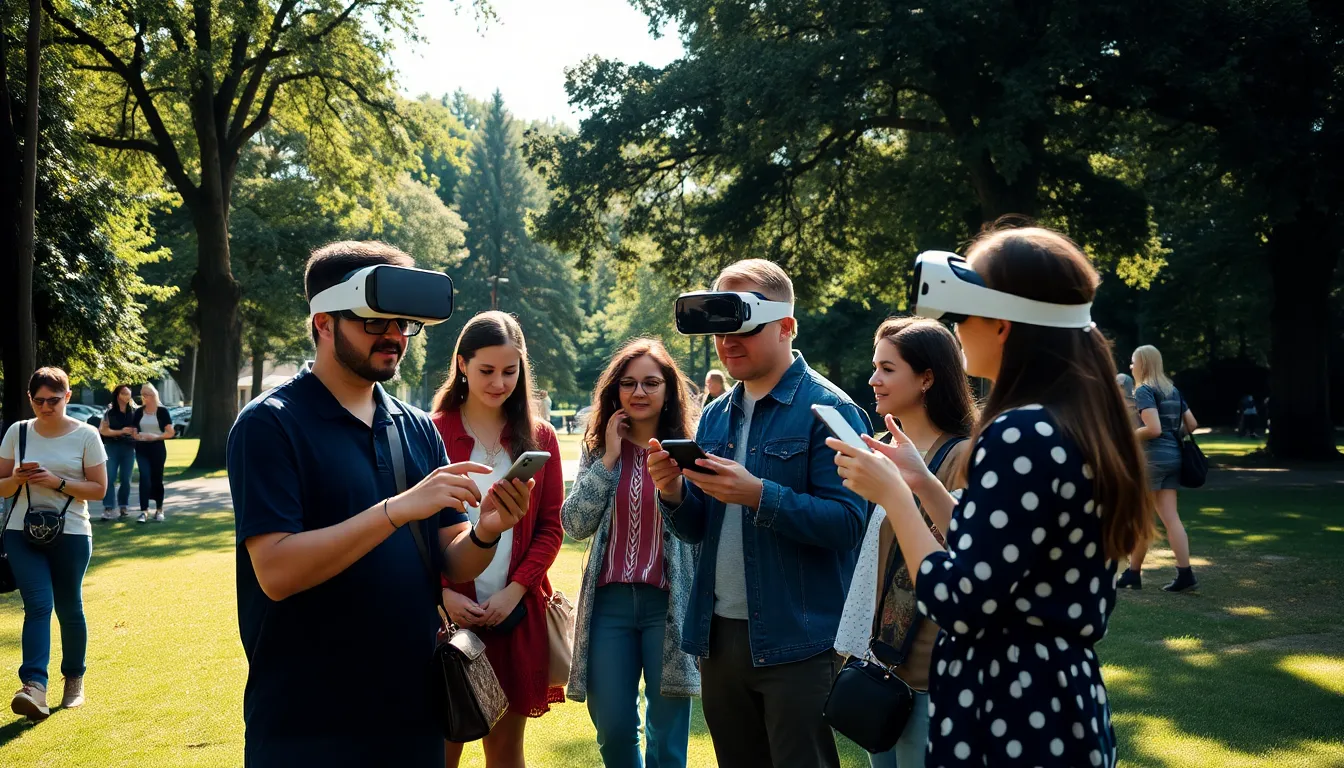Imagine walking through a world where your smartphone doesn’t just capture moments but enhances them. Welcome to the realm of Augmented Reality (AR) UI design, where digital elements blend seamlessly with reality. It’s not just a tech trend; it’s a game-changer that’s transforming how users interact with their environment.
Table of Contents
ToggleOverview of AR UI Design
AR UI design incorporates digital elements within a user’s physical environment, enhancing interactions in real time. This integration requires a thoughtful approach to ensure seamless coexistence of virtual and real-world features. Effective AR interfaces prioritize user experience by focusing on usability and intuitive navigation.
Designers often utilize spatial awareness to position virtual objects accurately in the user’s surroundings. Successful AR applications depend on the clarity of information presented. Simple interfaces reduce cognitive load, allowing users to focus on their tasks without distraction.
User feedback shapes the ongoing development of AR UI design. Regular testing with diverse audiences identifies usability issues and preferences. Understanding user context enhances the application’s relevance and effectiveness in real-world scenarios.
Adaptability plays a crucial role in AR UI design. Designers must consider varying environments, light conditions, and user behaviors. Customizable settings empower users to tailor their experience according to personal preferences.
Integration of gestures and voice commands enhances interactivity within AR UI. This allows users to engage with digital content naturally, improving immersion. Ensuring consistent performance across devices further heightens usability and accessibility.
AR UI design reflects a strategic blend of technology and creativity. Collaboration between designers, developers, and users fosters innovative solutions. Prioritizing aesthetics alongside functionality leads to a more engaging and effective user experience.
Key Principles of AR UI Design

AR UI design hinges on principles that enhance user experiences through effective integration of digital elements in real-world settings.
User-Centric Approach
User-centric design forms the foundation of AR UI. Prioritizing user needs ensures that interfaces remain intuitive and engaging. Regular testing with diverse audiences reveals usability issues and preferences. Feedback shapes continuous improvement, guiding designers toward solutions that resonate with users. Customizable options empower users to personalize their experiences. An effective user-centric approach fosters engagement and satisfaction, making the technology feel accessible and relevant in everyday life.
Contextual Awareness
Contextual awareness serves as a guiding principle in AR UI design. Designers must consider users’ surroundings to create seamless interactions. Understanding factors such as light conditions, spatial dynamics, and environmental changes ensures optimal placement of virtual elements. Successful applications enhance user experiences by blending digital and physical worlds without disruption. Adaptability remains crucial, allowing interfaces to respond effectively to different contexts. Prioritizing contextual awareness helps deliver enriched, immersive encounters that resonate with users in meaningful ways.
Tools and Technologies for AR UI Design
Various tools and technologies facilitate the creation of effective AR UI designs. These resources empower designers to craft experiences that integrate seamlessly with the real world.
Design Software
Popular design software includes Adobe XD, Sketch, and Figma. Each offers unique features for creating user interfaces tailored to AR applications. Adobe XD supports interactive prototypes, while Sketch fosters collaboration among teams. Figma stands out with its browser-based functionality, enabling real-time collaboration. Tools like Unity and Vuforia allow designers to visualize and manipulate 3D elements within AR environments. These design solutions streamline the workflow and enhance creativity in AR UI projects.
Development Platforms
Key development platforms include ARKit for iOS, ARCore for Android, and Unity. Apple’s ARKit provides robust features for creating AR applications on iPhones and iPads, with capabilities for motion tracking and environmental understanding. Google’s ARCore offers similar functionalities for Android devices, enhancing cross-platform capabilities. Unity excels in building interactive AR experiences, leveraging its versatile game engine. These platforms support developers in combining digital content with the physical world, fostering intuitive user interactions.
Challenges in AR UI Design
AR UI design faces unique challenges that impact usability and functionality. Designers encounter various obstacles that require innovative solutions.
Technical Limitations
Technical constraints often hinder the AR experience. Hardware limitations include processing power, battery life, and display quality, which affect performance. Various devices present inconsistent levels of support for AR features. Connectivity issues can disrupt seamless data exchange, leading to lag and decreased engagement. Moreover, operating systems may lack the necessary frameworks for robust AR development, limiting design possibilities. These challenges necessitate thoughtful planning and optimization to ensure smooth interactions across devices.
User Experience Issues
User experience in AR applications is prone to several issues. Navigating complex interfaces can overwhelm users, leading to frustration. Different physical environments create inconsistencies in how users interact with virtual elements. Distraction from real-world surroundings can impair focus, making it difficult for users to engage meaningfully. Additionally, motion sickness from poorly calibrated experiences negatively impacts user retention. Prioritizing clarity and simplicity in design mitigates these challenges, ensuring a more enjoyable and effective interaction.
Future Trends in AR UI Design
The landscape of AR UI design continues to evolve rapidly, with emerging technologies and shifting user needs shaping its future.
Emerging Technologies
Artificial intelligence plays a crucial role in AR UI design advancements. It enables more personalized experiences by analyzing user behavior and preferences. Additionally, 5G technology significantly reduces latency, facilitating smoother interactions between virtual elements and the real world. Wearable devices offer new interfaces for AR experiences, allowing users to engage without requiring handheld devices. Spatial computing technologies improve object recognition and tracking, enhancing accuracy in positioning virtual assets. Blockchain integration also emerges as a trend for secure transactions in AR applications, increasing trust among users.
Evolving User Needs
User expectations for AR experiences continually change, driven by increased digital interaction. Users now prioritize intuitive interfaces that require minimal learning time. Flexibility in customization options becomes essential, allowing users to tailor experiences according to individual preferences. Enhanced accessibility features cater to diverse audiences, ensuring inclusivity across different demographics. Fast adaptation to environmental changes is critical, as users navigate various settings and lighting conditions. Collecting and analyzing user feedback helps designers implement improvements that address real-world challenges, ensuring that AR experiences remain relevant and engaging.
AR UI design stands at the forefront of merging digital and physical experiences. Its potential to reshape user interactions is immense. By prioritizing user needs and embracing adaptability designers can create intuitive interfaces that resonate with diverse audiences.
The ongoing evolution of AR technology calls for continuous innovation and responsiveness to user feedback. As new tools and trends emerge the focus on clarity and simplicity will remain essential. This approach not only enhances usability but also fosters deeper engagement.
Ultimately AR UI design is about creating seamless experiences that enrich everyday life. As the landscape evolves designers must remain committed to pushing boundaries while ensuring that user satisfaction is always at the heart of their creations.








